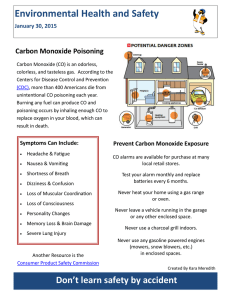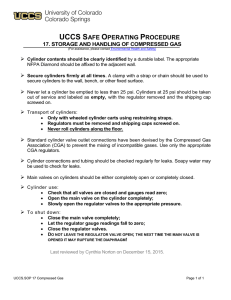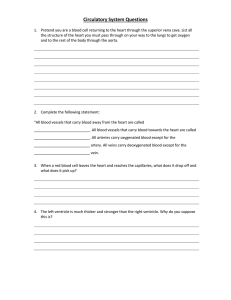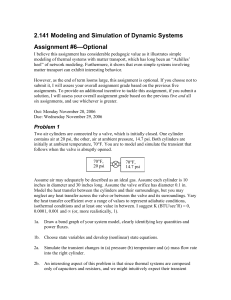Carbon monoxide
advertisement
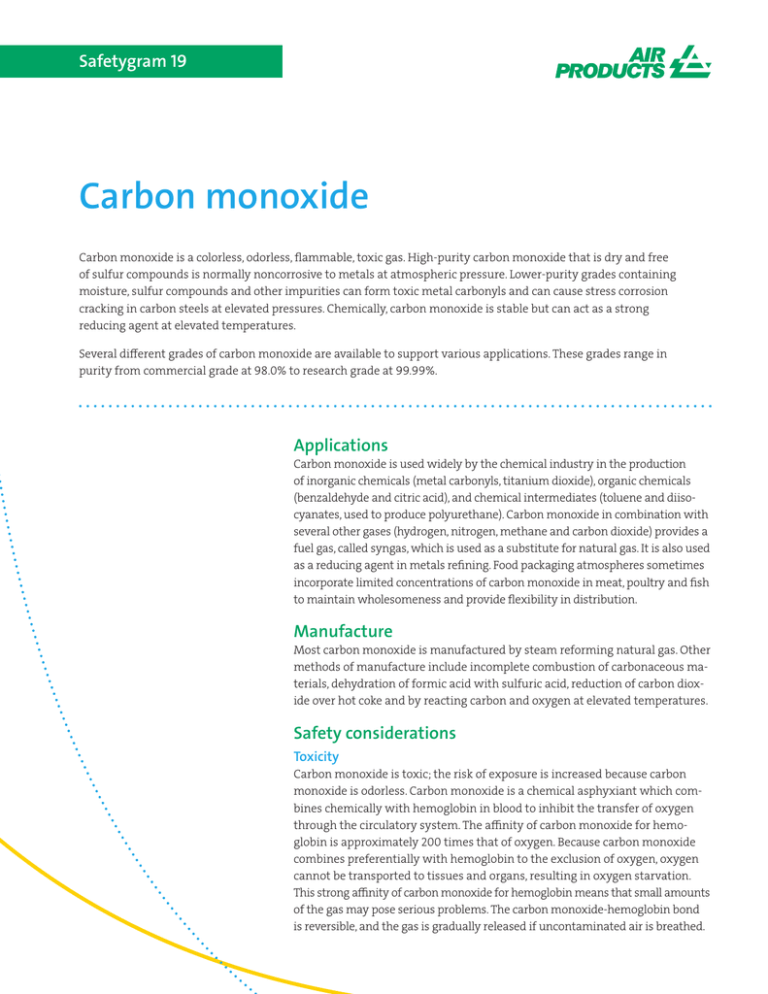
Safetygram 19 Carbon monoxide Carbon monoxide is a colorless, odorless, flammable, toxic gas. High-purity carbon monoxide that is dry and free of sulfur compounds is normally noncorrosive to metals at atmospheric pressure. Lower-purity grades containing moisture, sulfur compounds and other impurities can form toxic metal carbonyls and can cause stress corrosion cracking in carbon steels at elevated pressures. Chemically, carbon monoxide is stable but can act as a strong reducing agent at elevated temperatures. Several different grades of carbon monoxide are available to support various applications. These grades range in purity from commercial grade at 98.0% to research grade at 99.99%. Applications Carbon monoxide is used widely by the chemical industry in the production of inorganic chemicals (metal carbonyls, titanium dioxide), organic chemicals (benzaldehyde and citric acid), and chemical intermediates (toluene and diisocyanates, used to produce polyurethane). Carbon monoxide in combination with several other gases (hydrogen, nitrogen, methane and carbon dioxide) provides a fuel gas, called syngas, which is used as a substitute for natural gas. It is also used as a reducing agent in metals refining. Food packaging atmospheres sometimes incorporate limited concentrations of carbon monoxide in meat, poultry and fish to maintain wholesomeness and provide flexibility in distribution. Manufacture Most carbon monoxide is manufactured by steam reforming natural gas. Other methods of manufacture include incomplete combustion of carbonaceous materials, dehydration of formic acid with sulfuric acid, reduction of carbon dioxide over hot coke and by reacting carbon and oxygen at elevated temperatures. Safety considerations Toxicity Carbon monoxide is toxic; the risk of exposure is increased because carbon monoxide is odorless. Carbon monoxide is a chemical asphyxiant which combines chemically with hemoglobin in blood to inhibit the transfer of oxygen through the circulatory system. The affinity of carbon monoxide for hemoglobin is approximately 200 times that of oxygen. Because carbon monoxide combines preferentially with hemoglobin to the exclusion of oxygen, oxygen cannot be transported to tissues and organs, resulting in oxygen starvation. This strong affinity of carbon monoxide for hemoglobin means that small amounts of the gas may pose serious problems. The carbon monoxide-hemoglobin bond is reversible, and the gas is gradually released if uncontaminated air is breathed. Carbon monoxide is colorless, tasteless, odorless, and is detectable only by specific techniques or instrumentation. For these reasons, special precautions are required when hazardous concentrations are possible. Table 1: Carbon Monoxide Physical and Chemical Properties Flammability When mixed with air, carbon monoxide poses an immediate fire hazard. Carbon monoxide has a very broad flammability range. The flammable range, sometimes referred to as the explosive range, is the range of vapor concentration in air that will burn or explode if ignition energy is introduced. The limiting concentrations for the range are the Lower Flammable Limit (LFL) and the Upper Flammable Limit (UFL). Any concentration between the LFL and the UFL will burn or explode if an ignition source is introduced. Concentrations below the LFL are too lean to burn, while those above the UFL are too rich to burn. However, concentrations above the UFL should not be considered safe, because they will dilute at the interface with the atmosphere and pass through the flammable range. Lower Flammability Limit (LFL): 12.5% Upper Flammability Limit (UFL): 74.2% Autoignition Temperature: 1148˚F (620˚C). 2 Chemical formula CO Molecular weight 28.01 Boiling point @ 1 atm –312.7˚F –191.5˚C Melting point @ 1 atm –337.2˚F –205.1˚C Critical temperature –220.4˚F –140.2˚C Critical pressure 507.5 psig 3499 kPa, abs Gas density @ 70˚F (21.1˚C), 1 atm 0.075 lb/ft3 0.0012 g/cm3 Specific gravity (air = 1) 0.9676 Specific volume @ 70˚F (21.1˚C), 1 atm 13.8 ft3/lb 0.862 m3/kg Flammability limits 12.5% vol LFL 74% vol UFL Pressure Carbon monoxide is shipped as a compressed gas at pressures up to 2000 psig. Pressure is stored energy and must be handled correctly to prevent uncontrolled releases. A compressed gas cylinder containing pressure can be propelled at speeds of greater than 35 miles an hour if the valve is accidentally sheared. Unsecured pressurized lines can also cause damage if uncontrolled pressure releases occur. Treat all pressurized containers and equipment with respect and never perform maintenance or work on pressurized equipment. See Safetygram-14, “Don’t Turn a Cylinder Into a Rocket,” for more information. Containers Carbon monoxide is shipped and stored in high-pressure cylinders, tube trailers or ISO modules, depending on the quantity required by the consumer. These containers are manufactured according to applicable codes and specifications for the temperatures and pressures involved. Cylinders A typical steel cylinder is a hollow tube with a closed concave base that permits the cylinder to stand upright. Aluminum cylinders have flat bases. The opposite end is tapered to a small opening that is threaded to accommodate the installation of a valve. A threaded neck ring is attached to the tapered end to allow a protective cylinder valve cap to be installed. Carbon steel and aluminum are the primary materials of construction for carbon monoxide. Aluminum is the preferred material because it eliminates the possibility of iron pentacarbonyl formation and stress corrosion cracking. Cylinders are sometimes manifolded together in a pack or bank to provide larger volumes while minimizing cylinder changes. See Safetygram-10, “Handling, Storage, and Use of Compressed Gas Cylinders,” for more information about cylinders. Table 2: Exposure Limits ACGIH 8-hour Time Weighted Average (TWA) 25 ppm NIOSH Recommended Exposure Limit (REL) 35 ppm OSHA Permissible Exposure Limit (PEL) 50 ppm NIOSH Immediately Dangerous to Life and Health (IDLH) 1200 ppm Lethal Concentration 50% of test subjects die (LC50) 1807 ppm (0.18%) (4 hr, rat), 3760 ppm (0.38%) (1 hr rat) Lethal Concentration lowest concentration for death (LCl0) 5000 ppm (0.50%), 5 minutes, human Table 3: Symptoms CO Concentration (ppm) Time of Exposure 25 8 hours Symptoms TWA maximum exposure allowed in workplace 50 Typical bloodstream level for a 1 pack a day smoker 200 2–3 hours Mild headache, fatigue, nausea, and dizziness 400 1–2 hours Serious headache, other symptoms intensify, life threatening after 3 hours 800 45 minutes Dizziness, nausea, convulsions, unconscious within 2 hours, death within 2–3 hours 1600 (0.16%) 20 minutes Headache, dizziness, nausea, death within 1 hour 3200 (0.32%) 5–10 minutes Headache, dizziness, nausea, death within 1 hour 6200 (0.62%) 1–2 minutes Headache, dizziness, nausea, death within 30 minutes 12,800 (1.28%) Death 1–3 minutes 3 Tube trailers, ISO modules, and ground storage tubes If large amounts of product are required, carbon monoxide can be supplied in tube trailers or ISO modules. The most common configurations for these units are in eight tube bundles of 12 meter (40 ft) by 56 cm (22 in) diameter tubes. These units carry as much as 820 kg (1800 lb) of carbon monoxide. Figure 1 shows a typical carbon monoxide tube trailer. Some applications will require larger quantities than are practical to be delivered in cylinder quantities but do not have the room or the space requirements for tube trailers or ISO tube modules. Ground storage tubes may be used to satisfy these applications. Ground tubes can be sized to various volumes to meet specific needs. Ground tubes are similar to the tubes used in tube trailers and ISO modules but are permanently mounted at the site. See Figure 2. They can be sized and manifolded together to meet a customer’s volume requirements while fitting within their space limitations. Valves, connections, and pressure relief devices Valves Carbon monoxide containers are supplied with a variety of valves, depending upon the grade and application of the product. Each cylinder valve has its own specific operating requirements. These include the correct way to open and close the valve. Please see Air Products’ Safetygram-23, “Cylinder Valves,” for identifying features, detailed operating instructions, strengths and weaknesses, and cut-away drawings. If you are not sure which valve is on your container, contact your supplier for verification. 4 Figure 1: Typical Carbon Monoxide Tube Trailer Figure 2: Typical Ground Tube Installation Commercial grade carbon monoxide (typically >98.0% purity) Electronic grade carbon monoxide Valve connections (typically >99.9% purity) Valve outlet connections are designed Commercial grade is typically equipped with pressure-seal (backseating) valves. The pressure seal valve is a handwheel-operated valve using a two-piece valve stem. Air Products recommends pressure seal valves be used in the fully open or back-seated position. Opening the valve fully causes the lower stem to ride upward on its threads until it physically contacts the upper stem and mechanically drives the upper stem’s seal ridge into the packing ring. This improves the seal around the valve stem and helps to prevent leaks at the top of the valve. If the valve was back-seated using substantial effort, it is possible that the operator could think the valve is closed, when in fact it is fully open. Operators must be trained to use pressure readings or an equally reliable indicator to ensure the cylinder valve is closed or open. Close the cylinder valve tightly using a gloved hand. Air Products recommends always wearing gloves when operating cylinder valves. NEVER use wrenches or other persuaders to operate the valve. Electronic Grade product is usually equipped with a metal diaphragm valve. Air Products uses three different styles of diaphragm valves in carbon monoxide service: springloaded diaphragm, tied diaphragm and pneumatic tied diaphragm. The diaphragm valve utilizes a two-piece stem separated by non-perforated diaphragms. These diaphragms prevent leakage along the valve stem. The springloaded diaphragm valve encases the lower stem in a spring, which forces the stem away from the seat when the valve is opened. The tied diaphragm valve utilizes a two-piece stem connected through the diaphragms. The lower stem is physically pulled away from the seat instead of being lifted away by the spring. The tied diaphragm is available in a pneumatic version for remote operation. to promote ease of connection to high-pressure cylinder valves. Various regional regulatory organizations have developed standards for these connections to create continuity amongst the manufacturers. Table 4 shows the specific connections used for carbon monoxide in several regions of the world. For a more detailed explanation of how cylinder valve connections work, recommended closing torques, and cut-away diagrams, refer to Air Products’ Safetygram-31, “Cylinder Valve Connections.” Cylinder valve pressure relief devices Regulations in some regions of the world do not allow the use of pressure relief devices on high-pressure cylinders. In other regions, such as North America, pressure relief devices are required by the regulations. When a pressure relief device is required on a high-pressure cylinder containing carbon monoxide, a combination device consisting of a frangible disk (rated at not more than 1.67 times the working pressure of the cylinder) with a fusible alloy backing on the atmospheric side of the disk is required. These pressure relief devices are designed to function in times of fire, as the fusible alloy must melt out before the disk can function. For more information on pressure relief devices, refer to Safetygram-15, “Cylinder Pressure Relief Devices.” Table 4: Connections Used for Carbon Monoxide Type of Connection France NF-E 29-650 ThreadedE Germany DIN 477 Japan JIS-B-8246 United Kingdom BS 341 5 A(W22L) 4 Ultra High Integrity (DISS) has been adopted as an international ISO Standard United States CGA-V-1 350 724 Caution: The typical gasket used in the 724 connection is made of nickel. If this connection is used, the nickel gasket must be replaced with a stainless steel or PCTFE gasket. 5 Storage and handling Always store and handle cylinders containing compressed gases in accordance with international or local regulations, such as ISO 11625, “Gas Cylinders-Safe Handling.” For more information, refer to Air Products’ Safetygram-10, “Handling, Storage, and Use of Compressed Gas Cylinders.” Personnel must know and understand the properties, proper uses, and safety precautions for the specific product before using the product or associated equipment. Storage Cylinders should be secured in an upright position and stored in a wellventilated area protected from the weather. All precautions necessary for the safe handling of flammable gas must be observed with carbon monoxide. Avoid storing with oxidizers or other flammable materials. Carbon monoxide detectors with audible and visual alarms are highly recommended for protection of personnel. The storage area should be secure with limited access. Storage area temperatures should not exceed 52˚C (125˚F), should be free from combustible materials and should be free from ignition sources. Storage should be away from heavily traveled areas and emergency exits. Avoid areas where salt or other corrosive materials are present. Valve protection caps and valve outlet seals must remain on any unconnected cylinder. When returning a cylinder to storage, the valve outlet seal must be installed leak-tight and the cylinder cap secured. Separate full and empty cylinders. Avoid excessive inventory and extended storage time. Visually inspect stored cylinders on a routine basis, at least weekly, for any indication of leakage or other problems. Use a first-in, first-out inventory system and keep inventory records up to date. The use of “FULL,” “IN USE,” 6 Figure 3: The NFPA 704 Diamond for Carbon Monoxide Disposal Return unused product to the supplier. If product must be disposed of on-site, incineration using a suitable flare is typically used. Disposal of carbon monoxide must be done in an environmentally acceptable manner in compliance with all applicable national and local codes. System design and maintenance Materials of construction and “EMPTY” tags is highly recommended. Storage areas must be posted with the proper signage, such as “No Smoking,” “No Open Flames” or NFPA 704 ratings. Handling and use Use only in well-ventilated areas. If cylinders must be placed indoors, they should be in ventilated cabinets or hoods. Use a suitable handcart designed for cylinder movement. Do not drag, roll or slide cylinders. Never attempt to lift a cylinder by its cap. Secure cylinders at all times during storage and transport, and use an adjustable strap wrench to remove overly tight cylinder caps. Never insert anything into the cap holes to assist in cap removal. Ensure that the cylinder valve is properly closed, the valve outlet seal has been reinstalled leak-tight, and the valve protection cap is installed before returning to storage, moving or shipping the cylinder. When performing operations such as connection and disconnection involving toxic gases, it is advisable to use two people so one can act as a safety backup. Steel and other common metals are satisfactory when handling sulfurfree, dry carbon monoxide. Iron and nickel, present in steel or other metal alloys, can react with carbon monoxide at high pressure, especially when water and/or sulfur impurities are present. The carbonyls that may be formed from this reaction are extremely toxic. In addition to the formation of carbonyls, corrosion and/or stress corrosion cracking of iron and nickel alloys is possible, even at low pressures. Systems used in high-pressure carbon monoxide service are sometimes copper-lined to provide corrosion resistance. Highly alloyed chrome steels are resistant to these reactions, but it is suggested that users perform stress corrosion testing of materials of construction to ensure they will be compatible with the high-pressure use of carbon monoxide under actual conditions. Buildings Buildings where carbon monoxide is used should be adequately ventilated. Where large quantities are used, mechanical ventilation is recommended. When designing the ventilation systems, keep in mind that carbon monoxide is slightly lighter than air and may rise in the event of a leak. Toxic and/or flammable concentrations may pocket near ceilings. Electrical lines and equipment must comply with national and local building codes and with electrical codes for Class 1 hazardous areas. Monitoring Carbon monoxide is colorless, odorless, tasteless and nonirritating; the gas has no warning properties that can be detected by the human body. Because of this, monitoring is extremely important to identify potentially unsafe concentrations. This could include personal badges, handheld monitors or sensors, room monitors and environmental monitors. In many cases, it is advisable that monitors be tied in to an automatic shutoff system. Personal protective equipment (PPE) (minimum requirements) General cylinder handling Safety glasses with side shields, leather gloves and safety shoes. System operations In addition to safety glasses with side shields, leather gloves, and safety shoes: natural fiber clothing like cotton should be worn and flame retardant clothing such as Nomex can provide additional protection from fire. Emergency operations Self-contained breathing apparatus and total body covering with flameresistant material such as Nomex. First aid Skin and eye contact Carbon monoxide does not attack the eyes or skin in itself. However, in the event of a fire, treatment for burns may be necessary. Identification number UN1016 Shipping labels This is not a likely route for exposure. Poison Gas, Flammable Gas (Outside the US) Inhalation Hazard, Flammable Gas (Inside the US) Poison Gas, Inhalation Hazard, Flammable Gas (International going to or from the US) Inhalation Placard Ingestion Avoid hazardous exposure of rescue personnel. Safely remove victim to fresh air as quickly as possible. Trained personnel should administer supplemental oxygen and/or cardiopulmonary resuscitation, if necessary. Seek medical attention promptly. Keep victim warm. Poison Gas Firefighting Safetygram-23: “Cylinder Valves” The preferred method for fighting a fuel or flammable gas fire is to shut off the supply of gas, if it can be done safely, and allow the gas to burn until completely consumed. Potential hazards exist if a carbon monoxide fire is extinguished without stopping the flow of gas because of potential exposure of personnel to the toxic gas and the risk of reignition or explosion. In the meantime, protect the surrounding area and equipment from becoming involved. Water spray, carbon dioxide, dry chemical or foam extinguishing agents are effective against fires involving carbon monoxide. When fighting a carbon monoxide fire, positive pressure, self-contained breathing apparatus should be used for personnel protection. List of related Safetygrams referenced in text: Safetygram-10: “Handling, Storage and Use of Compressed Gas Cylinders” Safetygram-15: “Cylinder Pressure Relief Devices” Safetygram-31: “Cylinder Valve Connections” Figure 3: Transportation Labels Transportation information Shipping name Carbon Monoxide, Compressed, 2.3 (2.1), UN1016, Poison–Inhalation Hazard, Zone D Hazard class 2.3 (Poison Gas) 7 Emergency Response System T 800-523-9374 (Continental U.S. and Puerto Rico) T +1-610-481-7711 (other locations) For regional ER telephone numbers, please refer to the local SDS 24 hours a day, 7 days a week for assistance involving Air Products and Chemicals, Inc. products Technical Information Center T 800-752-1597 (U.S.) T +1-610-481-8565 (other locations) Monday–Friday, 8:00 a.m.–5:00 p.m. EST F 610-481-8690 gastech@airproducts.com For more information, please contact us at: Corporate Headquarters Air Products and Chemicals, Inc. 7201 Hamilton Boulevard Allentown, PA 18195-1501 tell me more airproducts.com © Air Products and Chemicals, Inc., 2014 (36201) 900-13-100-US

